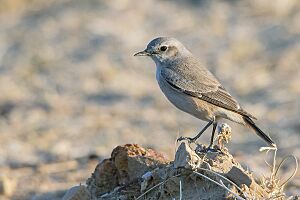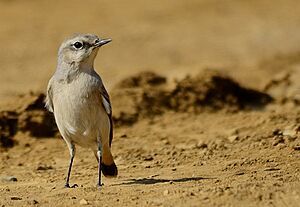Red-tailed wheatear facts for kids
Quick facts for kids Red-tailed wheatear |
|
|---|---|
 |
|
| Conservation status | |
| Scientific classification | |
| Synonyms | |
|
Oenanthe xanthoprymna chrysopygia |
The red-tailed wheatear (Oenanthe chrysopygia) is a small passerine bird. It is also known as the rusty-tailed wheatear, Persian wheatear, or Afghan wheatear. This bird lives and breeds in the mountains of south-west and central Asia.
It belongs to a group of birds called wheatears. These birds were once thought to be part of the thrush family. Now, scientists place them in the Old World flycatcher family. The red-tailed wheatear used to be seen as a type of Kurdish wheatear. However, many experts now consider it a separate species.
Contents
What Does the Red-tailed Wheatear Look Like?
This bird is about 14.5 centimeters (5.7 inches) long. Its wingspan is around 26–27 centimeters (10–10.5 inches). It weighs about 20-27 grams (0.7-1 ounce).
Its feathers are mostly dull grey-brown on top. They are greyish-white underneath. It has a light stripe above its eye. The feathers near its ears have a reddish tint. The feathers under its wings are silvery-white.
The lower back and the base of its outer tail feathers are reddish. The rest of its tail is black. This creates a T-shaped pattern on its tail. Males and females look very similar. However, males have a small black area between their eye and beak.
The female Kurdistan wheatear can look much like the red-tailed wheatear. But it usually has white bases on its outer tail feathers. Adult male Kurdistan wheatears look quite different. They have a black face and throat, and greyer upper parts.
The red-tailed wheatear's song is a simple, repeated whistle. It also makes several clicking, rasping, and whistling sounds.
How Did This Bird Get Its Name?
The red-tailed wheatear was first described in 1863. An Italian zoologist named Filippo de Filippi gave it the name Dromolaea chrysopgyia.
Later, some scientists thought it was a type of Kurdish wheatear. This was because they found birds that looked like a mix of both species. This suggested the two types could interbreed. However, these "mixed" birds might just be young Kurdish wheatears.
Red-tailed wheatears living in the eastern part of their range are a bit paler. Some people think they are a separate subspecies. A subspecies is a group within a species that has slight differences. This eastern group is sometimes called O. c. kingi.
Where Do Red-tailed Wheatears Live?
This bird breeds in an area from north-east Turkey and Armenia eastwards. Its breeding range includes Azerbaijan, Iran, Afghanistan, southern Tajikistan, and western Pakistan.
When winter comes, these birds fly south. They spend the colder months in the Arabian Peninsula, Eritrea, and parts of southern Iraq and Iran. They also winter in Pakistan and north-west India. Sometimes, a few birds might wander to places like Israel, Ethiopia, Djibouti, and Nepal.
They like to breed in mountainous areas. These are usually between 1,200 and 4,000 meters (about 3,900 to 13,000 feet) above sea-level. They build their nests on steep, rocky ground with very few plants. In winter, they move to lower areas. Here, they can be found on rocky hills, open grasslands, scrubland, and semi-deserts.
What Do Red-tailed Wheatears Eat?
Red-tailed wheatears usually look for food on bare ground. They mainly eat insects. Their diet includes ants, beetles, and caterpillars. They might pick food from plants. They also dig with their beaks to find beetle larvae. Sometimes, they will sit on a rock and fly down to catch insects.
Reproduction and Life Cycle
These birds breed from late March or April until June. They usually have two sets of babies each year.
The nest is shaped like a cup. It is made from grass and other plant materials. They build their nests in holes found in rocks, stones, or walls. The female lays four to six eggs. The eggs are then incubated (kept warm) for 13 days. The eggs are pale bluish-white. Sometimes, they have small reddish-brown spots.



